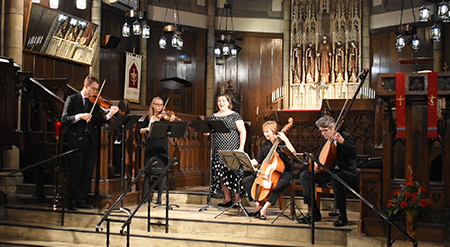by Nicholas Stevens

Violinist Andrew Fouts, gambist Patricia Halverson, and theorbist Scott Pauley appeared at Akron’s Holy Trinity Lutheran Church on Sunday, May 20 under the auspices of the Arts @ Holy Trinity series. Violinist Alice Culin-Ellison and soprano Kathryn Copeland Donaldson joined the original players.
Monteverdi’s “Laudate Dominum” from the Selva Morale et Spirituale gave Donaldson a chance to show off her impressive range. Light, warm, and agile, her voice has all the qualities that fans love about early-music singing. Fouts, Halverson, and Pauley wisely held back, but gave exposed moments appropriate muscle.
Culin-Ellison brought a bright, crisp sound to the opening melody of Legrenzi’s Sonata “La Cornara,” a tune that starts out blustering and assertive but almost immediately melts into sobs almost immediately. Like most sonatas of the period, this suite is organized in connected sections rather than movements. The third found Pauley and Halverson leaning into low passages — thereby demonstrating their now-rare instruments’ potential for alluring intensity.
Having introduced the theorbo and its most famous advocate, Giovanni Kapsberger, Pauley launched into a beautiful rendition of his Sonata Arpeggiata. This became the first “movement” of an ensemble-compiled suite of works by the theorbist-composer, including a Sinfonia duodecima à due canti in which Fouts and Culin-Ellison moved and phrased together, yet allowed the contrast between their respective tone qualities to stand out. Fouts held a whisper-soft drone for much of the Piva, a bagpipe-inspired movement. The Canario swept over the Holy Trinity’s vaults like a ray of afternoon sunlight.
In contrast, Bertali’s Sonata à 3 cast a shadow that Buxtehude’s Herr, wenn ich nur dich habe quickly dissipated: Culin-Ellison and Fouts wove garlands of sound around Donaldson’s free, clear vocal lines. The instrumentalists’ performance of Vivaldi’s Trio Sonata in G minor — the first piece the composer published — afforded a look at a famous artist at the start of his career. Fouts, Culin-Ellison, and Halverson unleashed familiar-sounding cascades of notes in the Allemanda, and the in-your-face clashes of the Adagio lay mere steps away from those in the Winter concerto from The Four Seasons. The players showed restraint in a Capriccio marked by quiet, skittering rhythmic figures.
As in many of Handel’s later opera arias, the soprano lines of his early Gloria consist of relentless torrents of melodic work — all of which Donaldson handled fearlessly. However, the church’s acoustics threatened to blur these virtuosic runs beyond audibility. The slow movements called attention to Handel’s penchant for sneaking acrid dissonances into his more anguished vocal pieces. The “Quoniam tu solus sanctus” passed abruptly into the connected “Cum Sancto Spiritu” in a sudden shift of gears from the merely pleasant to the thrilling. To punctuate this well-curated and expertly performed concert, Chatham Baroque placed the most viscerally exciting music at the very end.
Photo: Sean G. Donaldson.
Published on ClevelandClassical.com May 24, 2018.
Click here for a printable copy of this article



